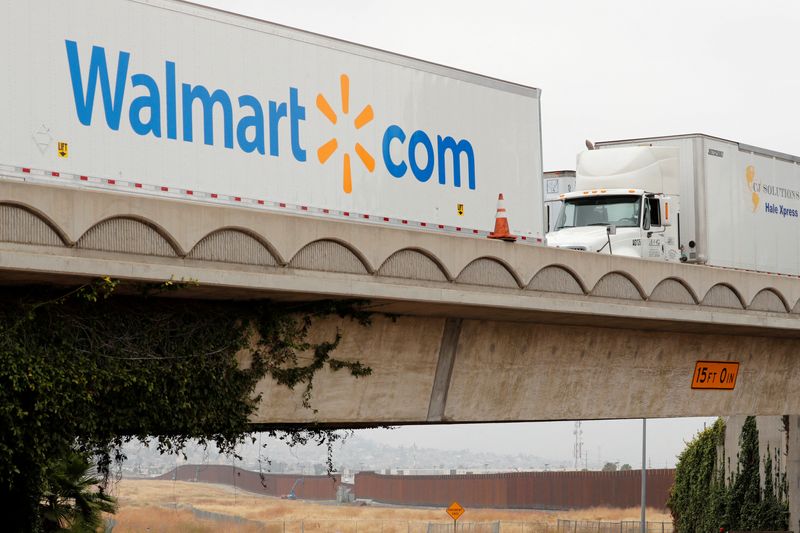Analysis-US retailer holiday orders should boost transport demand, but risks loom
2023.05.24 06:16

© Reuters. FILE PHOTO: Transport trucks from Mexico cross into the United States at the Otay Mesa border crossing in San Diego, California, U.S. May 31, 2019. REUTERS/Mike Blake/
By Lisa Baertlein
LOS ANGELES (Reuters) – The slumping U.S. transportation sector could be bouncing off a bottom as retailers start preparing for the back-to-school season and winter holidays, but political brinkmanship in Washington and interest rate hikes could threaten long-term consumer demand, economists and supply chain executives said.
Retailers like Walmart (NYSE:) and Target (NYSE:) have largely tackled bloated unsold inventories and are taking steps to restock, transportation executives said. That activity is being closely monitored because consumer spending accounts for more than two-thirds of U.S. economic activity and fuels significant transportation demand.
Ships, planes, trucks and railroads that move goods sold by retailers enjoyed a boom early in the COVID-19 pandemic as people sheltered at home.
But much of that demand evaporated when restrictions lifted and consumers resumed travel and indoor dining last spring. Retailers, stuck with too much merchandise, stopped ordering – sending transportation rates swooning and leaving providers with too much capacity.
Some say that downward trend could start to reverse in 2023 for transporters.
Retailers have already placed holiday orders this year, said Jack Kleinhenz, chief economist for the National Retail Federation (NRF) industry group.
Wholesalers and retailers are “continuing to be very conservative with inventory,” said Greg Javor, senior vice president of global supply chain operations for Mattel (NASDAQ:), seller of Barbie dolls and Hot Wheels toy cars.
“We expect things to be normal … in the second half of the year with the inventory corrections pretty much behind us,” Javor said at the Reuters Events supply chain conference in Chicago last week.
Retail orders are filled by factories and then shipped to buyers, creating a time lag of weeks to months. The typical peak season for container imports is in the autumn, due to holiday orders, but has occurred earlier during the pandemic.
Even so, U.S. imports already have returned to pre-pandemic levels, bolstering hopes for a transportation uptick in the second half of 2023.
“The biggest piece that we’re watching right now is, ‘What is going to happen with consumer demand and how does that end up?’,” said Drew Wilkerson, CEO of freight brokerage RXO.
WORRIES REMAIN
Indeed, glimmers of good news are tempered by ongoing worries about a standoff over raising the federal government’s borrowing cap and the U.S. Federal Reserve’s efforts to tamp down inflation with interest rate hikes.
U.S. consumer sentiment slumped to a six-month low earlier this month. And Federal Reserve officials have signaled they expect interest rates to stay high or go higher, given sticky inflation – dashing investor hopes for a rate cut.
“The problem is that the longer higher inflation sticks around, the longer people expect it to remain,” NRF’s Kleinhenz said.
The American Association of Port Authorities (AAPA) earlier this month called out demand risks in general retail merchandise and household durable goods, which account for more than half of U.S. ocean imports.
While general merchandise stores are unlikely to be aggressive about ordering, the real estate sector that brings in appliances, furniture, tiling, floor covers and other goods for new homes is being pummeled by rising interest rates, AAPA said.
Still, DHL Express Americas CEO Mike Parra is betting U.S. consumers will remain resilient and he feels “optimistic” about year-end activity.
Still, Parra will be watching retail restocking in August, September and October. “That is the indicator for me as to what’s going to happen in quarter four,” Parra said.








